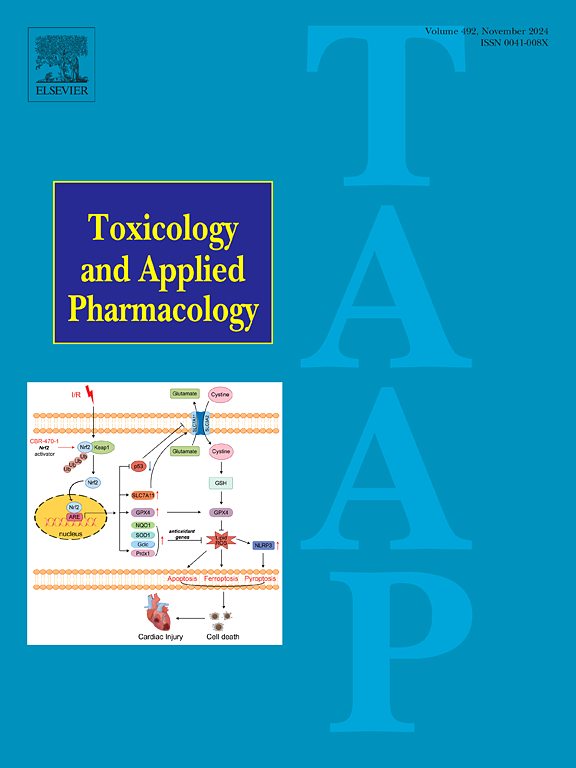Chronic arsenic exposure of ovarian surface and fallopian tube cultures induces giant and/or multinucleated cells with phagocytosis-like properties and an inflammatory phenotype
IF 3.4
3区 医学
Q2 PHARMACOLOGY & PHARMACY
引用次数: 0
Abstract
Chronic exposure to arsenic, a toxic metalloid frequently found in groundwater and food, represents a significant environmental health risk and has been implicated in the etiology of several cancers, including ovarian cancer. However, the precise pathways through which arsenic exerts its toxic impact on the ovary are not fully understood. This study investigates the impact of chronic arsenic exposure at environmentally relevant concentrations (75 ppb or μg/L) on primary human ovarian surface (OCE1) and fallopian tube (FNE1) cultures derived from the same donor. These heterogeneous cultures provide a unique, human-relevant platform to investigate how chronic arsenic exposure influences distinct cell types within a shared microenvironment. Prolonged arsenic exposure induced significant cytotoxicity and promoted the formation of giant and/or multinucleated cells in both cultures. These cells exhibited phagocytosis-like properties, actively engulfing apoptotic debris. Transcriptomic analyses and pathway enrichment revealed robust activation of pro-inflammatory signaling, notably the canonical NF-κB pathway. This was marked by nuclear translocation of the NF-κB p65 subunit and elevated expression and secretion of pro-inflammatory cytokines, including TNFα, IL-6, and IL-8, driving a sustained inflammatory response. Moreover, arsenic-exposed cells displayed persistent DNA damage, as indicated by increased γ-H2AX foci, accompanied by nuclear structural alterations and elevated expression of cancer stem cell markers, including OCT2, CD133, and ALDH1. These findings suggest that arsenic-induced inflammation and genomic instability converge to promote a tumor-supportive microenvironment, highlighting the potential role of chronic arsenic exposure in ovarian carcinogenesis, particularly in the context of inflammation-driven carcinogenesis.

卵巢表面和输卵管培养物的慢性砷暴露诱导具有吞噬样特性和炎症表型的巨核和/或多核细胞
砷是一种经常在地下水和食物中发现的有毒类金属,长期接触砷是一种重大的环境健康风险,并与包括卵巢癌在内的几种癌症的病因有关。然而,砷对卵巢产生毒性影响的确切途径尚不完全清楚。本研究探讨了环境相关浓度(75 ppb或μg/L)的慢性砷暴露对来自同一供体的人卵巢表面(OCE1)和输卵管(FNE1)培养物的影响。这些异质培养提供了一个独特的、与人类相关的平台,以研究慢性砷暴露如何影响共享微环境中不同的细胞类型。在两种培养中,长时间的砷暴露诱导了显著的细胞毒性,并促进了巨核和/或多核细胞的形成。这些细胞表现出类似吞噬的特性,积极吞噬凋亡碎片。转录组学分析和通路富集显示促炎信号的强大激活,特别是典型的NF-κB通路。这是通过NF-κB p65亚基的核易位和促炎细胞因子(包括TNFα、IL-6和IL-8)的表达和分泌升高来标志的,这些细胞因子驱动了持续的炎症反应。此外,砷暴露的细胞显示出持续的DNA损伤,如γ-H2AX灶增加,伴随着核结构改变和癌症干细胞标志物(包括OCT2、CD133和ALDH1)的表达升高。这些研究结果表明,砷诱导的炎症和基因组不稳定性共同促进了肿瘤支持微环境,强调了慢性砷暴露在卵巢癌发生中的潜在作用,特别是在炎症驱动的癌变背景下。
本文章由计算机程序翻译,如有差异,请以英文原文为准。
求助全文
约1分钟内获得全文
求助全文
来源期刊
CiteScore
6.80
自引率
2.60%
发文量
309
审稿时长
32 days
期刊介绍:
Toxicology and Applied Pharmacology publishes original scientific research of relevance to animals or humans pertaining to the action of chemicals, drugs, or chemically-defined natural products.
Regular articles address mechanistic approaches to physiological, pharmacologic, biochemical, cellular, or molecular understanding of toxicologic/pathologic lesions and to methods used to describe these responses. Safety Science articles address outstanding state-of-the-art preclinical and human translational characterization of drug and chemical safety employing cutting-edge science. Highly significant Regulatory Safety Science articles will also be considered in this category. Papers concerned with alternatives to the use of experimental animals are encouraged.
Short articles report on high impact studies of broad interest to readers of TAAP that would benefit from rapid publication. These articles should contain no more than a combined total of four figures and tables. Authors should include in their cover letter the justification for consideration of their manuscript as a short article.

 求助内容:
求助内容: 应助结果提醒方式:
应助结果提醒方式:


